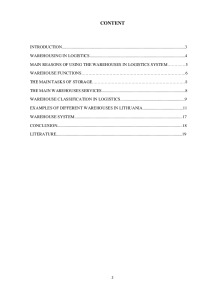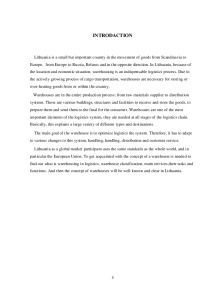Warehousing In Logistics Essay



Introduction. Warehousing in logistics. Main reasons of using the warehouses in logistics system. Warehouse functions. The main tasks of storage. The main warehouses services. Warehouse classification in logistics. Examples of different warehouses in lithuania. Warehouse system. Conclusion. Literature.
The main goal of the warehouse is to optimize logistics the system. Therefore, it has to adapt to various changes to this system, handling, handling, distribution and customer service.
Lithuania as a global market participant uses the same standards as the whole world, and in particular the European Union. To get acquainted with the concept of a warehouse is needed to find out what is warehousing in logistics, warehouse classification, main services,their tasks and functions. And then the concept of warehouses will be well known and clear in Lithuania.
Warehousing logistics is a complex of interrelated operations that are implemented in the process of transforming material flow in a warehouse. It is a logistical operation consisting in the maintenance of stocks by the participants of the logistic channel and ensuring the safety of stocks, their rational allocation, accounting, continuous updating and safe working methods.
Warehousing in logistics is a branch of logistics that deals with the development of methods for organizing warehousing, the procurement system, acceptance, placement, inventory control and inventory management in order to minimize the costs associated with warehousing and processing of goods. It is also a complex of interrelated operations implemented in the process of transformation of the material flow in the warehouse economy.
It should be borne in mind: warehouses contribute to the transformation of cargo traffic by changing the parameters of received and issued consignments in terms of size, composition, physical characteristics of incoming goods, time of shipment of transport lots, etc. In the warehouse system, material flows that are based on transport functions movement of materials) and storage (in addition to warehousing, various types of leveling of the flow of goods passing through the warehouse are carried out).
Main reasons of using the warehouses in logistics system
ensuring uninterrupted production process by creating stocks of material and technical resources;
ensuring maximum satisfaction of consumer demand by forming a range of products;
Warehousing is a great importance in providing production and satisfying customer needs. Supplying and meeting needs is highlighted through warehouse functions.
Equalizing functions are the elimination of the mismatch between the need for materials and their receipt. There may be a discrepancy between duration and quantity.
Warranty functions. Possible supply disruptions may result in a shortage of raw materials. As a result, stockpile stocks are guaranteed to ensure an uninterrupted technological production process.
Speculative functions. Larger stocks are purchased in the raw materials market under favorable circumstances. This surplus stock may subsequently be sold at higher prices or used in production.
Improvement functions. Improvement is an integral part of the production process because the materials or raw materials exposed to the relevant storage conditions have better quality properties.
Warehouses have the following key functions in the company's logistic system activities:
• Equalizing material intensity and adapting its volume to consumer demand.
• Changing the range of material flows according to customer orders.
There are a large number of different warehouses. When choosing a room for a warehouse should be aware of the classification. This classification allows us to evaluate the warehouse on the most important consumer qualities. Warehouses can vary in size, design, degree of mechanization of warehousing operations, by type of storage, by function. Warehouse can be a link in the chain of movement of products for production purposes or be on the site of movement of consumer goods.
















